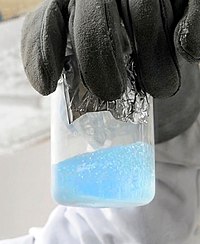
Photo from wikipedia
Abstract Phosphate oxygen isotope ratios provide a powerful tool for paleoclimate reconstruction and the study of phosphorus biogeochemistry in aquatic systems. The temperature dependent offset between the oxygen isotope composition… Click to show full abstract
Abstract Phosphate oxygen isotope ratios provide a powerful tool for paleoclimate reconstruction and the study of phosphorus biogeochemistry in aquatic systems. The temperature dependent offset between the oxygen isotope composition of phosphate and water in biogenic minerals and in solutions has been used extensively in paleoclimate research and the study of phosphorus cycling in aquatic and soil environments. Sample sizes are small in many applications, e.g., serial sampling of mammalian tooth enamel for paleoseasonality studies, the use of conodont elements for climate and ocean δ 18 O reconstruction, or the isolation and analysis of dissolved phosphate from marine and freshwater environments in biogeochemistry studies. This has pushed the development of techniques that allow for processing and analysis of a few micromoles of phosphate. Current approaches to phosphate oxygen isotopic composition (δ 18 O p ) determination require purification of phosphate as silver phosphate (Ag 3 PO 4 ). The techniques for the final precipitation of Ag 3 PO 4 fall into two categories: slow vs. rapid microprecipitations. We have tested both and identify artifacts that impact measured δ 18 O p values resulting from commonly used methods for rapid Ag 3 PO 4 precipitation. In particular, commonly used methods are prone to (a) incomplete precipitation of phosphate, with associated isotopic fractionation, and (b) the production of silver oxide contaminants whose oxygen isotope composition is sensitive to the δ 18 O of water used to prepare the precipitation reagent solution. These artifacts are commonly on the order of 0.5 to 2‰, which is subtle enough to go undetected in many studies, but large enough to cause errors in temperature estimates on the order of 2–8 °C. Slow microprecipitations lead to complete precipitation of phosphate without contaminating O-bearing phases. We develop a rapid precipitation technique that avoids the problems noted above. Both the slow microprecipitation and the rapid microprecipitation developed herein lead to δ 18 O p measurements that are indistinguishable from those made on conventional large-batch precipitations of Ag 3 PO 4 .
Journal Title: Chemical Geology
Year Published: 2017
Link to full text (if available)
Share on Social Media: Sign Up to like & get
recommendations!